Almost three years since the beginning of the war in Ukraine, experts explain how the conflict is unfolding militarily and what might happen next.
Russia continues to advance in eastern Ukraine and target the energy infrastructure. But Ukraine now has an additional advantage, the permission from the United States to strike deep into enemy territory.
Experts consulted by Sky News explain the current military positions of Ukraine and Russia and how the conflict could unfold.
What is the current situation on the front line
When Russian tanks entered Ukrainian territory in February 2022, Russia's objective was to overthrow the government and bring this country into Moscow's sphere of influence, not the West's. Despite not having achieved this objective so far, Russia has managed to consolidate its control over a "significant portion" of eastern Ukraine, says British defense expert Simon Diggins.
According to him, the eastern regions include a large part of Ukraine's industry and provide a land bridge to Crimea, which Russia annexed in 2014. "From this perspective, (the Russians) have probably succeeded or are certainly on the way to succeeding. They have not completely taken control of all these provinces, but they have a significant part," he explains.

Regarding the front line position, Russian troops continue to advance, albeit very slowly, and hold the advantage in terms of the issues they can cause through aerial attacks.
John Foreman, former UK military attaché to Moscow and Kiev, says that Russia currently holds the initiative in the war, which it has had over the past year.
The Ukrainian incursion into Russia's Kursk region may have caught Moscow off guard, but "it has not changed the course of the war" in Ukraine's favor, says Foreman.
And Diggins believes that Ukraine "has absolutely no chance" of regaining the regions under Russian occupation, but has demonstrated that it can defend itself effectively.
What resources each side has
US President Joe Biden authorized Ukraine on Sunday to launch long-range attacks with American tactical missiles (ATACMS) on Russian territory.
ATACMS has a range of up to 306 kilometers, but Foreman says that these missiles will not help Ukraine shoot down Russian planes conducting aerial attacks on many of its cities.
"Russia has used all the weapons in its arsenal to try to gain the upper hand. It uses Iranian drones in a constant campaign to wear down Ukrainian civilians and enhances their effect with cruise missiles and long-range ballistic missiles. Russia also improves the explosive power of its drones and has used guided bombs to hit Ukrainian positions," explains Foreman.
On the other hand, there has been an increased use of drones and cruise missiles produced in Ukraine, but not at the levels required to have a decisive military or economic impact, he mentions.
The types of weapons Ukraine can already use to strike Russian targets within its borders are the British Storm Shadow missiles and the SCALP missiles produced by France.
Kyiv is now requesting non-nuclear, long-range missiles like the German Taurus missile and effective air defense systems.
In terms of human resources, Russia benefits from the support of North Korean troops, "a worrying development," according to Diggins. However, in the long term, this assistance could pose more challenges for the Russians.
"They are probably all disciplined, but they have had no real conflict experience. I don't think the Russians will want to be too dependent on them. There is a challenge in using others' soldiers in your battles," says the expert, adding that the North Koreans could suffer heavy losses in a confrontation with an army close to Western standards like that of Ukraine.
What the next 1,000 days could look like
Both experts predict the end of the conflict next year through a compromise, as neither party has achieved significant gains so far.
Foreman anticipates that this winter the leadership in Kiev will consider accepting territorial concessions to ensure the survival of a free Ukrainian state. "That being said, without firm security guarantees or a ceasefire, Russia will be able to regroup and attack again," emphasizes the former military attaché.
Diggins predicts that in the next six to nine months, there may be a form of ceasefire, with a "land for peace" type of agreement.
But that won't be all.
"The next complicated step will be whether the West will support Ukraine. I doubt Ukraine will quickly gain NATO membership. One of the conditions Putin will need to agree to a ceasefire will be for Ukraine not to officially join NATO," adds the expert.
T.D.

